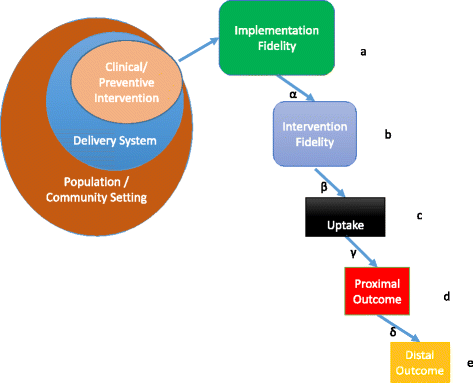"Scaling-out" evidence-based interventions to new populations or new health care delivery systems
- PMID: 28877746
- PMCID: PMC5588712
- DOI: 10.1186/s13012-017-0640-6
"Scaling-out" evidence-based interventions to new populations or new health care delivery systems
Abstract
Background: Implementing treatments and interventions with demonstrated effectiveness is critical for improving patient health outcomes at a reduced cost. When an evidence-based intervention (EBI) is implemented with fidelity in a setting that is very similar to the setting wherein it was previously found to be effective, it is reasonable to anticipate similar benefits of that EBI. However, one goal of implementation science is to expand the use of EBIs as broadly as is feasible and appropriate in order to foster the greatest public health impact. When implementing an EBI in a novel setting, or targeting novel populations, one must consider whether there is sufficient justification that the EBI would have similar benefits to those found in earlier trials.
Discussion: In this paper, we introduce a new concept for implementation called "scaling-out" when EBIs are adapted either to new populations or new delivery systems, or both. Using existing external validity theories and multilevel mediation modeling, we provide a logical framework for determining what new empirical evidence is required for an intervention to retain its evidence-based standard in this new context. The motivating questions are whether scale-out can reasonably be expected to produce population-level effectiveness as found in previous studies, and what additional empirical evaluations would be necessary to test for this short of an entirely new effectiveness trial. We present evaluation options for assessing whether scaling-out results in the ultimate health outcome of interest.
Conclusion: In scaling to health or service delivery systems or population/community contexts that are different from the setting where the EBI was originally tested, there are situations where a shorter timeframe of translation is possible. We argue that implementation of an EBI in a moderately different setting or with a different population can sometimes "borrow strength" from evidence of impact in a prior effectiveness trial. The collection of additional empirical data is deemed necessary by the nature and degree of adaptations to the EBI and the context. Our argument in this paper is conceptual, and we propose formal empirical tests of mediational equivalence in a follow-up paper.
Keywords: Delivery system fixed; Effectiveness; Evidence-based intervention; External validity; Implementation science; Intervention adaptation; Mediational equivalence; Multilevel mediation modeling; Population fixed; Scaling-out; Scaling-up.
Conflict of interest statement
Ethics approval and consent to participate
Not applicable.
Consent for publication
Not applicable
Competing interests
GAA is an Associate Editor and CHB is on the Editorial Board of Implementation Science. All decisions on this paper were made by another editor. NB receives salary support from a subcontract from the University of Chicago that is supported by Gilead, the maker of PrEP, which is mentioned in this paper. The authors declare that they have no other competing interests.
Publisher’s Note
Springer Nature remains neutral with regard to jurisdictional claims in published maps and institutional affiliations.
Figures
References
-
- Department of Health and Human Services. Dissemination and implementation research in health (R01) NIH funding opportunity: PAR-16-238. NIH grant funding opportunities; 2016. p. 2017.
-
- Cook TD, Campbell DT, Day A. Quasi-experimentation: design & analysis issues for field settings. Boston: Houghton Mifflin; 1979.
-
- Cronbach LJ, Shapiro K. Designing evaluations of educational and social programs. San Francisco: Jossey-Bass; 1982.
-
- Cook TD. Social prevention and the social sciences: theoretical controversies, research problems, and evaluation strategies. Berlin: Walter de Gruyter; 1991. Meta-analysis: its potential for causal description and causal explanation within program evaluation; pp. 245–285.
Publication types
MeSH terms
Grants and funding
LinkOut - more resources
Full Text Sources
Other Literature Sources
Medical


